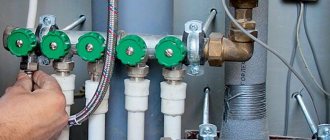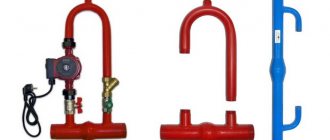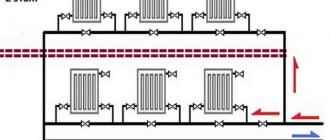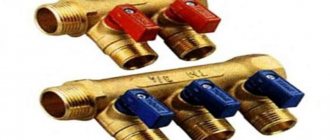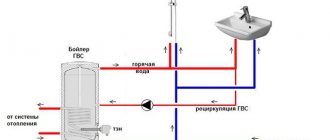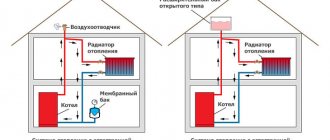One of the designs designed to warm up a private home is a single-pipe heating system. This system is quite simple, so it is often adopted by owners of private houses. This article will discuss the single-pipe heating scheme of a private house and its features.
Construction of a single-pipe heating system
The key feature of this system is that the supply and removal of coolant are carried out by one pipe, to which all heating devices installed in series are connected through connections. The main line is connected to the heat source and then returns to it, thereby closing the circuit. To ensure the required pressure, the system has a vertical pipe through which the water rises to the top point and moves further as it cools.
Heating through one pipe will be a little different in a private house with two floors. In this case, water from a vertically installed riser passes through the heating circuits. On the ground floor, the riser is lowered to floor level, resulting in the formation of an accelerating manifold. The pipe then passes throughout the house, supplying water to connected heating devices, and after that it enters the heat source.
The scheme of a single-pipe heating system in a private house with two floors has its own characteristics:
- The cross-section of the main line does not change in sections of the pipeline;
- When passing through individual heating devices, water loses some of its temperature, and this trend will continue until the liquid enters the heating zone;
- As the temperature of the liquid drops, the number of sections in the battery should gradually increase in the direction of movement of the coolant.
However, the described process can be compensated for by proper planning, which will allow you to do without additional sections. If the heated liquid gets first into the living quarters, and then into the utility rooms, then there will be no need to expand the batteries.
As a rule, for the normal functioning of a single-pipe heating system, forced movement of water is used, which requires a circulation pump - in this case, the heating operation will be stable, but volatile.
If there are some concerns about power outages, then a gravity-flow single-pipe heating system for the home is installed. It works according to the principle described above: an accelerating manifold is installed, located at a height of at least 2 meters from the floor level.
In order for the system to function, an expansion tank will be required, installed above the highest point of the pipeline circuit. As a rule, the installation location for the tank is the attic. A tank connected to the system ensures its operation, but the efficiency of the gravity system, even with proper arrangement, leaves much to be desired - the movement of water due to the temperature difference cannot be called intense enough.
A closed single-pipe heating system with forced circulation, which is provided by a pump, works much better. In such designs, membrane expansion tanks are used, since the system has a closed loop. However, an accelerating manifold will still be required - it will maintain the water level in all batteries and contribute to the normal movement of the coolant.
Having received the results
During the calculations, the optimal pipe size is determined. However, it should be borne in mind that the final design must be carried out by professionals and using much more complex formulas and diagrams. The number of elbows, connection method, optimization of costs, economic feasibility and even aesthetic appearance are also taken into account. When choosing the diameter, the division of pipes into main and supply pipes, the presence of shut-off valves and control devices with the help of which heating is adjusted in individual rooms are taken into account.
Have you managed to independently select the diameter of the heating pipe? Alternatively, you can try to recalculate the parameters of your existing heating and determine its efficiency. It may be worth reconsidering some points to achieve better results, especially in savings. Leave your results, as well as your opinion about this instruction, in the comments below the article.
A common mistake with old natural circulation heating systems is related to pipe routing. The elbows were formed too angular and with a narrowed cross-section, which leads to a significant increase in hydrodynamic resistance. To reduce resistance, it is necessary to maintain the correct turning radius (for steel pipes this is 2-2.5D) and use a pipe bender to maintain the pipe profile.
Classification of single-pipe heating systems
There are two different types of single-pipe heating systems:
- Vertical . This type of system is used in two-story buildings. In this case, the devices are located under each other (only a slight displacement is allowed) and are connected by a common riser. Structurally, this circuit is more similar to a combined one, since the difference between the supply and return lines is very clearly visible in it. A pump is not required in this system, but it can always be installed for reliability.
- Horizontal with bottom wiring. This single-pipe heating scheme is used in one-story houses with a small area. Natural circulation in this case is quite sufficient, although there are also systems with an installed pump.
You can connect heating devices in three ways:
The most widespread is the bottom connection of radiators, which is valued for its almost invisible pipes, which improves the interior of the premises. However, from the point of view of efficiency, this option is far from ideal - the heat transfer of the batteries in this case is noticeably reduced.
The best option is a diagonal pipe supply scheme, in which the heating devices warm up properly and demonstrate maximum efficiency. In any case, before making a one-pipe heating system, you need to develop a project that shows the smallest details of the future design.
Tips for choosing pipe diameters and connections
A single-pipe heating option can be designed and installed independently, without resorting to complex hydraulic calculations. Let’s simplify the task and give useful recommendations on the design of single-circuit systems:
- The maximum number of heating devices on one loop of a closed Leningradka is 5 pcs. To deliver the required volume of coolant to the batteries, a pipe Ø25 mm (DN20) is sufficient. We make the connections from pipes Ø16 mm.
- If, due to objective reasons, the number of radiators on 1 ring of a closed system needs to be increased, the cross-section of the main line is increased to a diameter of 32 mm (DN25), the liner - to 20 mm. It is not economically feasible to install more than 7 batteries on one pipeline; it is cheaper to lay 2 smaller lines.
Examples of Leningradka installation in a wooden house and office space - The minimum diameter of a horizontal collector with natural circulation is DN40, outer diameter is Ø48 mm. In a two-story house, the accelerating riser and the beginning of the distribution branches are made from a DN50 pipe (Ø57 mm), remote areas are reduced to a size of DN32. Vertical lines to radiators - DN20-25 depending on the thermal power of the heaters.
- To automatically regulate heat transfer, select full-bore valves with thermal heads. The hole in standard radiator valves is too small.
- Connection to a wall-mounted or floor-standing gas boiler is made according to the standard diagram shown in the picture below. The wiring of an electric water heating apparatus is done in a similar way.
- It is better to connect the Leningradka solid fuel boiler through a three-way mixing valve and a buffer tank. Since there is too little coolant in the system, there is a risk of overheating and boiling. Gravity distribution, holding more than 200 liters of water, can be connected directly to the TT boiler.
Typical connection diagram for a double-circuit wall-mounted boiler with a Leningradka
Important clarification. When assembling a home heating network, polypropylene pipes PN 22-28, reinforced with fiberglass, aluminum foil or basalt fiber, are often used. There is no standard size of 16 mm in the range of STABI PPR pipes; the minimum outer diameter is 20 mm. Accordingly, radiator connections are made with a cross-section of 20 x 2.8 mm.
Advantages and disadvantages of single-pipe systems
A single-pipe heating system for a private house has several significant positive qualities:
- Simplicity . Installation and repair of single-pipe heating is very often carried out independently by home owners - and all thanks to the simplicity of the design.
- Cheap . The cost of the system elements is quite low, which is largely due to the simplicity of such heating. The arrangement requires a fairly modest set of materials - for example, only two types of pipes are required (one for the main line, the second for the connections). A vertical system, naturally, will cost more, because it requires two pipeline circuits.
- Possibility of modification . If you have a budget, the system can be modified using radiator thermostatic valves, which allow you to regulate the temperature of each heating device separately. However, the two-pipe system remains popular. Quite often, the design of a two-pipe heating system for a two-story house allows you to solve many problems that a single-pipe system could not cope with.
Strengths and weaknesses of single pipe systems
The popularity of single-pipe heating in private construction is explained by the fairly low cost of the structure and the ability to independently carry out installation work. This makes it possible to save on hiring specialists.
Among other advantages of single-pipe systems, the following should be highlighted:
- High level of hydraulic stability. If you turn off some of the circuits, this will not affect the heat transfer of the remaining elements of the system. The same applies to replacing batteries or increasing the number of their sections.
- Low pipe consumption for organizing a main line.
- Slight inertia. To heat up the system, an order of magnitude less coolant is required than in schemes with two pipes.
- External aesthetics. Installation of a single-pipe system usually does not affect the beauty of the interior of the room, especially when using hidden laying of the main pipe.
- Thanks to the use of innovative shut-off valves (automatic and manual thermostats), it is possible to fine-tune the operating modes of the heating circuit and its constituent devices.
- Simplicity and reliability of the design, which makes it possible to install a single-pipe heating system on your own. The same applies to heating maintenance during operation.
By organizing the connection of control and monitoring devices for the heating system, it is possible to achieve its functioning in automatic mode. Integration into the Smart Home system is also allowed: as a result, it becomes possible to program optimal heating modes, taking into account the time of day, season, etc.
The main disadvantage of a single-pipe heating scheme is the presence of an imbalance between the heating of the radiators, depending on their distance from the boiler. This is explained by the gradual cooling of the coolant as it circulates through the pipes. As a result, the batteries closest along the coolant path turn out to be hotter than those located further away. In such cases, it is better to use cast iron devices, which are characterized by slow cooling.
Installation recommendations
When arranging a single-pipe heating system, despite its simplicity, it is necessary to carry out all stages of work carefully and competently, taking into account all the nuances and design features.
To ensure everything is done correctly, you should use the following recommendations:
- Before installation, it is necessary to correctly calculate in advance the dimensions of the pipes included in the structure;
- Pipelines should not cross the line of doorways, and risers should not be located near windows;
- For a system with forced circulation, DN15 pipes are suitable, and for a gravity system it is better to use DN20 pipes;
- We must not forget to observe the slope, which is 5 mm per 1 m of pipeline length in the case of a gravity system and 3 mm for a system with natural circulation;
- The accelerating manifold must be at least 2.2 m in height;
- An expansion tank installed in a cold attic must be insulated, and the pipe coming out of it must be taken outside;
- When using a cast iron heat exchanger in a boiler, you will have to do without cold feed on the return pipe near the heat generator;
- It is not worth installing too many batteries on one heating circuit - this always causes a lack of heat transfer from the last batteries.
Natural circulation
To ensure the movement of water in a gravity system, it will be necessary to construct an acceleration section. We are talking about a vertical pipe extending from the boiler, inside which the heated coolant moves upward. Upon reaching the highest point, the pipe smoothly turns back: this gives the water the necessary acceleration to move along the highway. Heating systems with overhead wiring do not require a separate pipe: its function is performed by a supply pipe raised to a sufficient height.
In one-story buildings with lower horizontal wiring, efficient heating will require an accelerating manifold. It should rise above the level of the first battery by no less than 1.5 m. Thanks to the acceleration section, circulation of the coolant in the gravity heating system becomes possible. The pipes in this section have a larger cross-section compared to the rest of the circuit. For example, if the diameter of the system pipes is 25-32 mm, then the acceleration section should have a diameter of 40 mm. The main advantages of the gravity system are its absolute energy independence (if a solid fuel boiler is used), simplicity of the device and the absence of complex components.
There are also disadvantages:
- To minimize hydraulic resistance, it is necessary to use large diameter pipes.
- The installation of any device and device leads to difficulty in the movement of the coolant, so there are certain restrictions on the number of shut-off valves (the fewer, the better). As a result, repair and maintenance becomes more complicated, since it requires a complete shutdown of the system and draining the coolant from the circuit.
- In order for the gravity system to be as reliable as possible, careful calculation and balancing will be required. This involves selecting optimal pipe diameters and the number of radiator sections. The batteries furthest from the boiler have to be made an order of magnitude wider: the coolant reaches them sufficiently cooled.
Features of single-pipe circuits
The main features are the use of a non-volatile heating source (solid fuel heating boiler, stove), natural coolant circulation (so-called “physics”) and one pipe for moving the coolant. The pipe can be homemade registers, industrial radiators and radiators connected in a series circuit, as well as ordinary large-diameter metal pipes (from Ø 40 mm and above). The classic single-circuit design uses an open expansion tank.
Single-circuit heating - diagram
Schematically, the wiring of a heating system from one circuit is a closed ring or system of rings, covering all rooms and premises from the coolant supply to the return. This solution is systematically modified and modernized, so it is not often found in pure form. The equipment may include needle valves, a bypass (a pipe jumper installed between the supply and return of a battery or radiator), a closed circulation circuit and forced movement of the coolant by a pump. Such modifications make it possible to eliminate almost all the shortcomings of the classical single-circuit system.
The traditional one-pipe heating system, the design of which is based on natural circulation, has a significant flaw - in order for the heating to work autonomously in the “physics” mode (without a circulation pump), it is necessary to install an accelerating manifold. For a one-story house, such a modification is problematic in terms of connecting the expansion tank to the autonomous housing water supply tank, but it can be solved, since with a ceiling height of ≥ 2200 mm, the insertion will not cause difficulties.
Acceleration manifold
The accelerating manifold serves as a coolant accelerator in a single-pipe system, and also maintains movement at a uniform and constant speed. The efficiency and noise level of autonomous heating depends on the height of the upper point of the accelerating manifold - the higher the manifold, the faster the coolant moves, and the quieter the heating system operates.
If single-pipe heating is installed in a two- or three-story house, then the collector does not need to be installed - the system will quickly and silently move the coolant without a pump. In the scheme for a one-story house, the collector serves as a direct continuation of the supply with a fixed upper point of the system, into which an expansion, supply, or expansion-consumable tank is connected.
Forced circulation circuit
Elimination of deficiencies using bypass
In addition, natural circulation achieves a reduction in the heating effect, and this will be felt on devices located at the farthest point; problems may also arise with heating the lower riser. It will warm up less. Everything depends on the correct installation of the system, and in this case, even devices with forced circulation will not be able to correct the defect. In this case, a bypass is used to close the coolant circulation. In simple words, this is a piece of pipe connecting the supply and return.
There is another option to correct the situation, but it is more complicated. The method consists of parallel insertion of all radiators into the main line, and additionally supplying them with control valves. And most importantly, it becomes possible to repair individual devices without draining the coolant.
Advice. Such installation is necessary if the heating boiler exceeds the system parameter in strength. The valves allow you to balance the temperature and not overheat individual rooms.
A two-pipe system, unlike a single-pipe supply, does not have such inconveniences. But everything is stopped with auxiliary devices. The bypass is equipped with valves that shut off the flow. If desired and possible, it can be made from the remains of pipes. The bypass circumference should be slightly smaller than the diameter of the risers. Otherwise, the liquid will not be evenly distributed, but will be discharged directly into the return line.
Experts recommend an approximate difference in diameter, from 5 to 10 mm. To achieve greater effect, the bypass should be located closer to the radiator. At the outermost device, just before the hole at the inlet, a thermostat is mounted. By taking into account these little things, the operation of heating devices will be more efficient. During acceleration, the same return will be natural and also forced circulation. The difference in thermal performance will be insignificant, even if you have to install the appropriate equipment in the process.
Pros and cons of a single-pipe scheme
Advantages:
- Low cost of components and low cost of installing the system due to the minimum number of pipes;
- Easy installation, including in hard-to-reach areas;
- The minimum length of the pipeline system allows you to achieve good decorative characteristics - the design of the premises will not be affected when disguising pipes under the floor, in walls and under door (window) openings;
- Minimum labor costs when installing the system.
Installation of pipes on baseboards
Flaws:
- To repair or replace sections of pipes, it is necessary to completely turn off the heating;
- Temperature spread along the length of the pipeline - the point closest to the boiler will always be the hottest, the most distant point will always be the coldest. To level out this drawback, it is necessary to increase the number of sections in them as the radiators move away from the boiler.
Closed tank
A closed expansion tank is a durable, sealed container separated inside by a flexible membrane. One part is inflated with air, and the second is connected to the pipeline. When the coolant heats up, its volume increases. As a result, the membrane bends towards the air section, which acts as a damper. Cooling the water leads to a decrease in hydraulic pressure. Thanks to compressed air, the system comes into equilibrium, squeezing excess water back into the main line.
Systems equipped with an expansion tank with a membrane are called closed. We are talking about sealed closed hydraulic circuits. The compensating tank can be installed on any part of the system. A popular installation location is the return pipe near the boiler: this increases the ease of maintenance of the tank.
In closed heating systems there is usually a slight excess pressure, so they are necessarily equipped with a safety group. The unit includes an air vent, a pressure gauge and a safety valve for discharging the coolant in emergency mode. These devices are installed on the supply pipeline, which allows shutdowns for repairs and maintenance. On elevated pipelines, the safety group is usually located at the highest point.
How does a single-pipe heating system work?
- A heating boiler using any type of energy carrier is the main component of the system;
- Heating points are batteries or radiators, sometimes large-diameter pipes. In modern radiators, cast iron is used less and less - most often these are bimetallic devices, since cast iron batteries are not without some disadvantages. This is an incomplete compliance of products with specifications, as a result of which the heating of rooms occurs with low efficiency, and external unattractiveness;
- The expansion tank is a mandatory component of a single-circuit heating system. The tank stabilizes the coolant pressure in the pipes and regulates the expanding volume of liquid. When the temperature of the coolant in the pipes increases, excess liquid is squeezed out into the expansion tank, and the coolant does not overheat;
- The process of supplying and adjusting coolant from the heating chamber to the system is controlled and distributed by shut-off valves - drain valves, correct wiring, Mayevsky valves. In a single-circuit system, reverse processes are impossible.
The simplest single-circuit circuit
What is taken into account when calculating
Main criteria that are important to consider:
- volume of coolant sufficient to fill the system;
- heating circuit length;
- rated coolant flow rate;
- required productivity, kW;
- circulation pressure;
- resistance of pipes and fittings in the heating circuit.
For each parameter there is a range of acceptable values. The calculation should give the size of the heating system pipe that satisfies all the requirements and provides optimal parameters.
Calculations refer to the internal diameter. After receiving the desired size, a suitable denomination is selected, which is commercially available, and then the material is selected. The wall thickness, outer diameter and appearance depend on this.
Single-circuit heating system
Heating devices in a single-circuit circuit are connected in series, and the heated coolant moves through all sections. The cycle of heat exchange ends at the last heater, and this represents a major drawback of the system. This shortcoming can be mitigated by installing more radiators, or installing balancing valves in the batteries.
Practical solutions for single-circuit heating schemes depend on the heated area. In a building with a total area of ≤ 100-150 m2, a scheme with natural coolant circulation will work satisfactorily. The balance of temperatures in the rooms is achieved due to the difference in the density of the coolant at different temperatures in different sections of the circuit. With a larger housing area, a scheme with forced circulation of coolant - using a circulation pump - will be effective.
Connecting the circulation pump
In a single-circuit heating system, return risers are not installed, so the pipes must also run along the top of the walls of the house. It is not difficult to assemble and connect such a circuit, especially since a minimum number of pipes is needed. What are the pipe routing options?
- The first solution is to use a flow-through riser system;
- The second solution is to use end sections of radiators, but you need to install a bypass in front of the radiator.
When implementing a flow-through scheme, a supply riser is not needed, and the heating radiators are connected from top to bottom, respectively, the coolant also moves from top to bottom. Since, according to the laws of physics, the water in the lower radiators will be less warm, fewer radiators can be connected on the upper floor(s). In this project, it is necessary to take into account the following circumstance: there is no need to install taps and valves on the radiators, since when the tap is turned off, the heat transfer will decrease and the heating of the room will also decrease. Also, with this scheme it is impossible to regulate the temperature in neighboring rooms.
Bypass
With a more advanced solution - installing bypasses - the coolant flows from the riser through the upper and lower heating radiators evenly. In this case, the coolant will cool more slowly, and the temperature on different floors will be approximately the same.
Necessary consumables and tools
To install a dead-end single-pipe circuit, you will need the following tools:
- adjustable wrenches;
- welding or soldering machine;
- hammer drill or electric drill;
- file.
You will also need the following consumables:
- radiators complete with fittings, plugs, taps and thermal valves, brackets;
- pipes, fastenings, bends, tees;
- three way valve.
In addition, materials will be required to insulate pipe connections.
Radiator with bypass
To insert bypasses into heating, PVC pipes with a smaller diameter than when connecting to radiators are used. If you take pipes of the same or larger diameter, the circulation of hot water will be incorrect. If it is not possible to connect small pipes, then to balance pipes of the same diameter, special valves are connected - two of each: on the supply and on the bypass, to regulate the supply of hot water to the radiator sections.
Bypass on the radiator
Installation of a single-circuit heating system
Before starting installation, it is necessary to calculate the hydraulic data of a single-circuit heating system. When carrying out calculations, the diameters of all pipes for different sections of the system are established. It is necessary to calculate a horizontal and vertical single-pipe heating circuit using coefficients that reflect pressure losses in different sections of the circuit. Water consumption is also calculated taking into account pressure loss coefficients in a single-circuit system. Then a schematic assembly of parallel instrument and circulation branches of the system is carried out.
Fastening pipes and other elements of a single-circuit heating system should begin with installing the boiler. Any heating unit must be installed below floor level, but not in the basement or basement. For the boiler (if it is solid, liquid or gas), a chimney is equipped, which is connected to the unit with a flexible corrugated galvanized pipe, the diameter of which must correspond to the outlet diameter of the boiler chimney. The main heating pipe is connected to the outlet pipe with the coolant; the standard pipe diameter is ¾ inch.
Heating wiring
An iron pipe should be connected to the boiler, and the transition to metal-plastic or PVC pipes is carried out at some distance from the firebox, so as not to expose the plastic to overheating. Plastic adapters cannot be used; only metal should be used - cast iron, brass, copper or bronze.
The expansion tank must be mounted at the highest point of the room, preferably at a height of ≥ 3 meters. If the attic of the house is insulated, then this will be the most suitable place for the expansion tank.
The next stage is the routing of pipes with coolant, and the installation of batteries (radiators), onto which Mayevsky taps and valves are simultaneously attached. The owner determines where to install radiators independently, but ergonomics indicates that the coldest places are under the window and near the entrance to the balcony, so it would be more rational to install them there. It is recommended to lay pipes without bends so that the coolant does not slow down in such areas.
Methods for connecting radiators
Most models of radiator assemblies allow connection to be made at two of the structurally provided points: at the top and bottom on the sides of the radiator.
There are several main connection types:
- diagonal , when the supply pipe is connected to the upper inlet on one side of the heater, and the outlet pipe is connected to the lower inlet on the opposite side. This is the most effective way;
- lateral , in which the coolant is supplied and discharged through a pair of holes located on one side of the heat exchanger;
- lower , when water enters and leaves the radiator through the lower pair of holes;
- single point connection . It is used only in extreme cases, when it is not possible to route a second pipe to the radiator. For such a connection, there are special injection connection units in which the pipes entering the radiator hole have different lengths.
Principle of operation
The main component of a single-pipe heating system for a private home is a heating boiler. It runs on various types of fuel: electricity, gas, coal, wood and other resources. The remaining elements can be schematically represented as a closed heating system, through which the coolant constantly moves. This circuit consists of various components.
It is possible to organize heating of the premises of a private house using heating radiators or to abandon them completely. Using the pipeline itself to transfer heat. Both water and antifreeze for equipment can be pumped into the internal space of the circuit, which will increase operating efficiency and heat transfer.
The operating principle of a single-pipe heating system for a private house is as follows: the liquid heated in the boiler begins to move from it to the first heater, where it imparts part of the thermal energy, then to the second, third, and so on. At the end of the chain the heating will be weakest. To compensate for this difference, you can reduce the size of the heater at the beginning of the journey and increase it at the end.
By installing various valves and valves on radiators, you can change the heat output in each area, which will allow you to use system resources more economically.
Design and principle of coolant distribution
The system is called single-pipe because heated water is supplied and leaves the heating radiators through a single collector. The pipeline is common to all batteries connected to the main branch. That is, the input and output connections of each heating device are connected to one pipe, as shown in the example of the heat supply diagram of a one-story building.
The classic version of a closed circuit with forced movement of coolant connected to a gas boiler
How does a single-pipe radiator heating system work:
- The heated coolant coming from the boiler reaches the first battery and is divided by a tee into two unequal flows. The bulk of the water continues to move straight along the main line, a smaller part flows into the radiator (about 1/3).
- Having transferred heat to the walls of the battery and cooled by 10-15 ° C (depending on the power and actual output of the radiator), a small flow through the outlet pipe returns to the common manifold.
- Mixing with the main flow, the cooled coolant reduces its temperature by 0.5-1.5 degrees. The mixed water is delivered to the next heating device, where the cycle of heat exchange and cooling of the main flow is repeated.
- As a result, each subsequent battery receives coolant with a lower temperature. At the end, the cooled water is sent back to the boiler along the same line.
Important point. In order for the heating circuit to operate stably, the diameter of the distribution pipe must significantly exceed the dimensions of the radiator connections. The rule does not apply to vertical risers with top filling, where the coolant is helped to flow downwards by gravity (read below about the types of systems).
The color and size of the arrows in the figure characterize the temperature and amount of water, respectively.
First, the flows are separated, then mixed, cooling by a couple of degrees . The lower the temperature of the circulating water, the less heat gets to the last heaters. The problem can be solved in three ways:
- at the end of the highway, batteries of increased power are installed - the number of sections is increased or the area of panel steel radiators is increased;
- by increasing the pipe diameter and pump performance, the coolant flow through the main collector increases;
- a combination of the two previous options.
Connecting radiators to a single distribution line is the main difference between single-pipe wiring and other two-pipe systems, where the supply and return of coolant is organized in two separate branches.
Features of the device in a two-story house
If you need to provide heating for a two-story house, then use a vertical circulation circuit for coolant movement. Risers are installed separately in it, and water is first supplied upward, and then begins to flow through all components of the circuit down to the heat generator.
It is recommended to use bypasses for bypasses, this will increase efficiency and also turn off an individual component in the event of a breakdown without completely stopping the system.
Heating equipment can operate with natural and artificial water circulation. If a heating circulation pump is not installed, the movement of the coolant occurs due to the different densities of the hot and cooled coolant. Features of the device in a two-story house are the use of larger diameter pipes and the need to install them at a certain slope. This entails additional costs for materials. Such a pipeline is more difficult to hide behind decorative elements. But the absence of a pump makes the equipment independent of the electrical network.
Single pipe vertical system
A single-pipe heating scheme for a home is quite convenient. In addition to the standard model using sectional batteries, you can install a “warm floor” heating system or build in a heated towel rail. In this case, you cannot do without a circulation pump.
This method of installing circulation for a single-pipe system is suitable for any type of room layout, and the small thickness of the pipes will allow them to be laid even under doorways. Which will improve the aesthetic design of the rooms. To achieve better heating quality, you can include two boilers in the circuit.
Water heating with natural circulation - operating principle
This system is called differently: thermosyphon, gravity or gravity. It consists of the following components:
- heat generator (boiler or stove/fireplace with a water jacket);
- a closed circuit of pipes and radiators filled with a coolant liquid (water, oil or antifreeze);
- expansion tank;
- shut-off and control valves;
- control and measuring instruments.
Heating up in the heat exchanger of a boiler or furnace, the working medium moves along the circuit, transferring thermal energy to radiators, which then heat the air in the rooms. The way the coolant moves through the system determines its main feature.
Failures in the heating system entail enormous inconvenience. In order to stabilize this system, they came up with a device called a bypass. Bypass in a heating system: what is it? Let's consider the design and functions of the mechanism.
We will discuss the operating principle of a heat pump here.
While apartments have central heating, residents of a private house must organize the heating system themselves. In this topic https://microklimat.pro/sistemy-otopleniya/vidy-otopleniya-chastnogo-doma.html we will consider what types of heating can be implemented in a country house. Boiler systems and alternative heating sources.
Operation of heating equipment
The peculiarity of the operation of heating equipment and the functioning of a single-pipe model is that connecting a circulation pump will reduce its efficiency. The pump serves to increase the speed of water movement; it is possible to achieve results without it. For high-quality heating, it is necessary to install an acceleration manifold. It will ensure acceleration of liquid in the pipeline and radiators.
It is advisable to use such a device in apartment buildings to maintain water acceleration. Not only the achieved temperature, but also the noise level depends on the quality of installation of the accelerating manifold.
Installation of the accelerating manifold
In a private house, an accelerating manifold is not necessary. Even if we are talking about a two or three-story building. The heating coolant will already rise to a sufficient height to ensure the required circulation rate.
Marking radiator installation locations
The batteries are installed in places where the greatest heat loss is observed. This includes window sill niches and external walls. The radiator is installed at a height of 20 cm from the floor. The distance to the window sill is 10-15 cm. In a residential building, it is not recommended to cover radiators with blank or half-open screens, as heat transfer worsens.
Flaws
The disadvantages of single-circuit heating lie in the way radiators and other devices are connected. In the first case, a serial connection is used. This greatly complicates the autonomous regulation of the heating temperature of individual rooms or even individual heating batteries of one room.
If there is a need to turn on or, conversely, turn off the heating of a room in the middle of the chain, you will have to use other rooms, at least at a minimum level. In this case, it is necessary to spend fuel on heating the unused part of the house. Partial adjustment can be made using thermostats and shut-off valves. On the other hand, a decrease in water heating will lead to a change in heat transfer in all areas.
It must be remembered that maintaining high pressure will help achieve better heat transfer performance; this can be achieved using a circulation pump.
But the circulation pump itself will consume electricity, increasing your monthly billing costs.
Liquid drainage must be done vertically. This is especially important in one-story buildings, in order to ensure long and uninterrupted operation, the pressure level in the devices should be controlled. The disadvantage of a single-pipe heating system can be compensated for by an expansion tank for discharging excess liquid. The expansion tank is installed at the highest point. To hide this item, you can install it in the attic.
Open tank
An open expansion tank is a partially or completely open tank connected to the circuit in its highest section, immediately after the boiler. To prevent the liquid from overflowing over the edges of the vessel, there is a special pipe closer to the top: it serves to drain excess water into the sewer or onto the street. When organizing heating of one-story buildings, a compensating tank is usually installed in the attic. To avoid freezing of water in winter, the walls of the tank are additionally insulated.
Such heating systems are called open. Most often we are talking about non-volatile or combined heating. In this case, the coolant comes into direct contact with the air: this leads to its natural evaporation and enrichment with oxygen.
Open circuits have the following disadvantages:
- Accurate observance of slopes (if gravity systems are used). This will allow the air leaking into the pipes to escape through the container into the atmosphere.
- The need for constant monitoring of the water level in the tank. From time to time, the volume of coolant must be replenished, since part of it evaporates through the open top.
- The use of non-freezing liquids that emit toxic substances during evaporation is prohibited.
- Oxygen saturation of the circulating fluid provokes corrosion processes inside metal steel heating radiators.
Strengths of open systems:
- You may not need to regularly check the pressure level in the pipeline.
- Small leaks in the circuit will not prevent it from properly heating your home. The main thing is that there is enough liquid in the pipes.
- To replenish coolant losses, it is allowed to use a simple bucket. This is done by simply adding water to the expansion tank to the required level.
Heating radiators EC
For gravity systems, the main thing is minimal resistance to water flow. Therefore, the wider the lumen of the radiator, the better the coolant will flow through it. Cast iron radiators are practically ideal from this point of view - they have the lowest hydraulic resistance. Aluminum and bimetallic ones are good to use, but you need to ensure that their internal diameter is at least 3/4”. You can use steel tubular batteries; steel panel batteries or any others with a small cross-section and high hydraulic resistance are definitely not recommended - either water will not flow through them or it will be very weak, which, for example, with a single-pipe system can lead to no circulation at all.
Systems with natural circulation (click on the picture to enlarge)
Connecting radiators has its own subtleties. The installation method is especially important in a single-pipe system: only with the help of different types of connections can better performance of the heating elements be achieved.
Radiator connection diagrams
The figure below shows radiator connection diagrams. The first is an unregulated daisy chain connection. With this method, all the disadvantages of the “Leningrad” will appear: different heat transfer from radiators without the possibility of compensation (regulation). The situation is a little better if you install a regular pipe jumper. With this scheme, there is also no possibility of regulation, but when the radiator is aired, the system functions, since the coolant passes through the bypass (jumper). By installing two additional ball valves behind the jumper (not shown in the figure), we get the opportunity to remove/turn off the radiator without stopping the system when the flow is blocked.
Features of connecting radiators in single-pipe systems
The last two installation methods allow you to regulate the coolant flow through the radiator and bypass - they contain devices for adjusting the radiator temperature. With this switching on, the circuit can already be compensated (heat transfer is set on each heating device).
No less important is the type of connection: side, diagonal or bottom. By operating these connections it is possible to facilitate/improve system compensation.
Connecting the battery to the main pipeline
The level of heat transfer from radiators is affected by the way they are connected to the main line:
- Diagonal (cross) . This option demonstrates the greatest efficiency. Makes it possible to heat radiators as much as possible over the area, practically eliminating heat losses. In this case, the supply pipe is connected to the upper radiator pipe, and the return pipe is connected to the lower pipe (it is located on the opposite side of the device). Diagonal connection is mandatory for multi-section radiators.
- Lateral (one-sided) . Provides uniform heating of all sections of the battery. In this scheme, the supply and discharge pipelines are located in the same direction. The side connection is most popular when organizing heating with top wiring.
- Nizhny . Least efficient connection method. Despite this, it is often used when the main pipe is hidden under the floor. The inlet and outlet pipes are connected to the lower outlets on different sides of the battery.
Boiler for gravity systems
Since such circuits are mainly needed for heating independent of electricity, the boilers must operate without the use of electricity. These can be any non-automated units, except pellet and electric ones.
Most often, solid fuel boilers operate in natural circulation systems. They are all good, but in many models the fuel burns out quickly. And if there is severe frost outside, and the house is not sufficiently insulated, then in order to maintain an acceptable temperature at night you have to get up and add fuel. This situation is especially common where people heat with wood. The solution is to buy a long-burning boiler (non-volatile, of course). For example, in Lithuanian solid fuel boilers Stropuva, under certain conditions, wood burns for up to 30 hours, and coal (anthracite) for up to several days. Candle boilers have slightly worse characteristics: the minimum burning time for wood is 7 hours, for coal - 34 hours. There are boilers without automation and pumps from the German company Buderus, the Czech Viadrus and the Polish-Ukrainian Wikchlach, as well as the Russian company Ogonyok.
Non-volatile long-burning boiler Stropuva
There are Russian-made gas-independent boilers, for example Conord, which are produced in Rostov-on-Don. They can be used in systems with natural circulation. The same plant produces energy-independent universal boilers “Don”, which are also suitable for operation without electricity. Floor-standing gas boilers from the Italian company Bertta, the Novella Autonom model, and some other units from European and Asian manufacturers operate in systems with natural circulation.
The second way to increase the time between fires is to increase the inertia of the system. For this purpose, heat accumulators (TA) are installed. They work well with solid fuel boilers, which do not have the ability to regulate the combustion intensity: excess heat is transferred to a heat accumulator, in which energy is accumulated and consumed as the coolant in the main system cools. Connecting such a device has its own characteristics: it must be located on the supply pipeline below. Moreover, for efficient heat extraction and normal operation - as close as possible to the boiler. However, for gravitational systems this solution is far from the best. They return to normal circulation quite slowly, but are self-regulating: the colder the room, the more the coolant cools as it passes through the radiators. The greater the temperature difference, the greater the density difference and the faster the coolant moves. And the installed TA makes the heating more inertial, and it takes much more time and fuel to accelerate. True, the heat is released longer. In general, it's up to you.
To stabilize the temperature, a heat accumulator is installed in the system
Stove heating with natural circulation has approximately the same problems. Here the role of a heat accumulator is played by the furnace array itself and a lot of energy (fuel) is also required to accelerate the system. But in the case of using TA, it is usually possible to exclude it, but in the case of a stove this is unrealistic.
Other ways to solve the problem
In addition to the use of cast iron batteries, the introduction of a circulation pump into the single-circuit system helps to optimize the situation. After this, the temperature in the heating circuits becomes more uniform, but too long pipelines still lead to its noticeable cooling.
To smooth out this unpleasant phenomenon, two methods are proposed:
- As you move away from the boiler, it is recommended to increase the number of sections on the radiators. In this way, an increase in their heat-releasing area is achieved: thermal energy begins to spread in greater quantities in the rooms, contributing to their uniform heating.
- Before carrying out single-pipe heating, it is necessary to consider the most rational placement of radiators in the rooms. It is better to place devices with the highest power in children's rooms, bedrooms and rooms on the cold north side. Further, the highway leads to the living room and kitchen. At the end of the circuit there are non-residential and utility rooms.
Thanks to these measures, some compensation for the shortcomings of the single-pipe system is achieved. This especially applies to low-rise buildings with an area of up to 150 m². In such cases, single-pipe heating is the most economical option.
